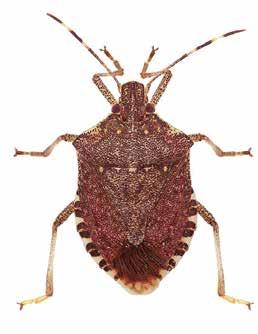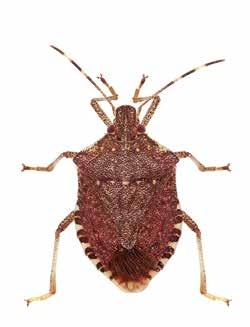
4 minute read
Biosecurity Watch
Tackling our most unwanted.
DR EDWIN MASSEY
Advertisement
I AM often asked, throughout the country, what the industry’s most unwanted pest is. This month’s column highlights the relaunch of the New Zealand Winegrowers ‘most unwanted’ list, which seeks to answer that question. To view the new poster click on the updated most unwanted link at www.nzwine.com/members/ sustainability/biosecurity/pests-anddiseases/
The most unwanted list – originally released in March 2014 - has been one of the key information resources for the industry on pests and diseases that are not present in New Zealand. Three years doesn’t seem like a long time, but in biosecurity nothing stands still and risks always come and go based on trade and travel volumes, dynamics, and other factors.
Key changes since 2014
The new list highlights the brown marmorated stink bug (BMSB) as the industry’s most unwanted pest. Very little was known about the potential impact of this bug before 2014, but since then it has become increasingly high profile. To date in this high risk season - extending from September to the end of April - there has been a significant increase in the number of BMSB interceptions at the border, particularly in goods from Italy. In February alone: • Several dead bugs were found at the border on an imported grape harvester that had been voluntarily fumigated offshore. • There have been three postborder detections of single bugs in Christchurch, Whitianga and New Plymouth. In each case, the detection has been associated with a specific pathway of introduction, and the bugs were identified as unmated females, which cannot establish a breeding population by themselves.
With such significant population pressure on the biosecurity system, it is not hard to see why BMSB must be considered our most significant threat.
A second key change to the list is the breakdown of the different pests and diseases into three categories: • Highest threat • Significant threat • Threat
This distinction has been made to focus attention on the threats most likely to cause severe impacts on the industry. The difference between pests and diseases in each category is less important than the distinction between categories. This means that New Zealand Winegrowers, as a prospective Government Industry Agreement (GIA) partner, will work with The Ministry for Primary Industries (MPI) to concentrate our biosecurity readiness efforts against our highest risk threats.
New Zealand Winegrowers, along with a range of horticulture industry organisations, is already engaging with MPI regarding the development of a BMSB operational agreement that will set out a suite of readiness activities to ensure we are best prepared to respond to this pest, should it be detected here.
Brown marmorated stink bug
IF YOU SEE ANYTHING UNUSUAL CATCH IT. SNAP IT. REPORT IT.


Call MPI biosecurity hotline 0800 80 99 66
What’s not on the list?
There are a myriad other biosecurity threats that have the potential to impact the industry and the Most Unwanted List is far from comprehensive. Risk analysis is based on making an assessment based on the likelihood and the consequences of a threat being realised. Insects such as the harlequin ladybird, which has recently established in northern New Zealand, and the lantern fly, which is currently under eradication in Pennsylvania, certainly warrant attention, as does the red blotch virus which is currently causing concern in the United States. As part of my role, I keep abreast of the literature and engage with MPI and overseas scientists to try to stay ahead of emerging risks. If anything significant changes, it is important to communicate that quickly to the industry.
Mitigating risks on your vineyard – the time to act is now
The Most Unwanted List identifies how pests and diseases are most likely to arrive in New Zealand and how they might move around. Establishing biosecurity risk mitigation activities on your vineyard is a good way to minimise the likelihood that these pests and diseases will impact you directly. The New Zealand Winegrowers draft vineyard health guidelines are available here for consultation: www.nzwine.com/ members/sustainability/ biosecurity/pests-anddiseases/
The theme of the guidelines is “it’s your asset, protect it”. If biosecurity is important to you - and it should be - ask yourself, “when am I going to set aside time to ensure I implement biosecurity risk mitigation activities on my vineyard?” Your action sends the message to others that biosecurity is important and must be considered part of industry business as usual.
Conclusion - Catch it; Snap it; Report it
All members have a key role in participating in the biosecurity system and the industry needs your commitment to help ensure its sustainability. If you spot anything unusual that you think could be on the most unwanted list, please Catch it; Snap it; Report it.
Ring the biosecurity hotline on 0800 80 99 66 immediately to notify MPI of your find.
If in doubt, please call or email me on 021 1924 924 or Edwin.massey@nzwine.com.
“All members have a key role in participating in the biosecurity system” Dr Edwin Massey IF YOU FIND ONE OF THESE:

2
1 CM
0
CATCH IT. CALL US.
EXOTIC PEST & DISEASE HOTLINE 0800 80 99 66
The brown marmorated stink bug are a major threat to our primary industries and environment. They can also ruin gardens and infest your home. If you find one: Catch it. Call us.






